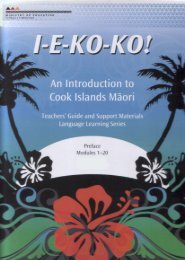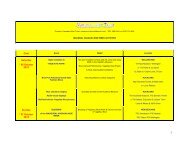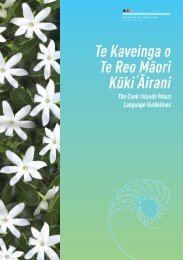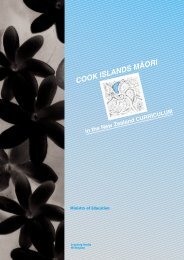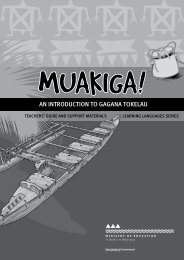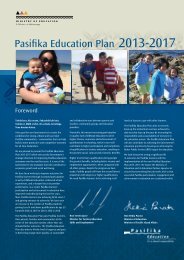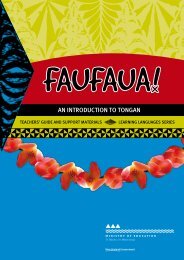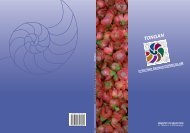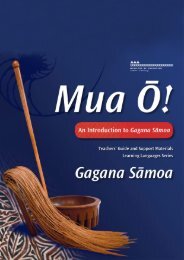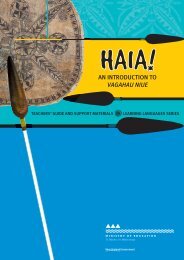Ta'iala mo le Gagana SÄmoa - Pasifika Education Community
Ta'iala mo le Gagana SÄmoa - Pasifika Education Community
Ta'iala mo le Gagana SÄmoa - Pasifika Education Community
You also want an ePaper? Increase the reach of your titles
YUMPU automatically turns print PDFs into web optimized ePapers that Google loves.
Feso‘ota‘igaCommunication‘O ni fa‘ata‘ita‘iga i <strong>le</strong> gagana Sā<strong>mo</strong>aSuggested aspects of gagana Sā<strong>mo</strong>a3.6 Use appropriate non-verbalfeatures in interactions,presentations, and performancesLearn appropriate actions and simp<strong>le</strong> claps (for examp<strong>le</strong>, pō, pati)for simp<strong>le</strong> sāsā and siva.Learn the actions for songs like “Tasi <strong>le</strong> Tama na Alu” and rhymeslike “Tasi Tasi Tasi Tātou Patipati”.Learn non-verbal ways of communicating in gagana Sā<strong>mo</strong>a,for examp<strong>le</strong>:• raising eyebrows to say hello;• nodding the head to signal “come here”;• walking behind visitors at an appropriate distance.Vāega 3: ‘O ni fa‘ata‘ita‘iga i <strong>le</strong> aganu‘u fa‘asā<strong>mo</strong>aLevel 3: Suggested aspects of fa‘asā<strong>mo</strong>aBy the time they have reached this <strong>le</strong>vel, students are beginning to understand that the way peop<strong>le</strong>use language is closely related to their culture. They may be ab<strong>le</strong> to incorporate appropriate gaganaSā<strong>mo</strong>a verbal and non-verbal forms of expression into their own language use. Students of Sa<strong>mo</strong>anheritage may do this intuitively. Students who do not share Sa<strong>mo</strong>an heritage may be <strong>le</strong>ss comfortab<strong>le</strong>attempting some of the body language outside the classroom un<strong>le</strong>ss they are interacting in gaganaSā<strong>mo</strong>a contexts and are supported in their efforts.62The tab<strong>le</strong> below suggests possib<strong>le</strong> aspects of aganu‘u fa‘asā<strong>mo</strong>a for the Cultural Know<strong>le</strong>dge strandat <strong>le</strong>vel 3.Atamai i <strong>le</strong> Aganu‘uCultural Know<strong>le</strong>dgeStudents will:‘O ni fa‘ata‘ita‘iga i <strong>le</strong> aganu‘u fa‘asā<strong>mo</strong>aSuggested aspects of fa‘asā<strong>mo</strong>aStudents could be <strong>le</strong>arning through experiences thatallow them to:• use forms of language, gesture, and <strong>mo</strong>vementthat are appropriate to special events andsituations;• use polite expressions like Tālofa lau susuga i <strong>le</strong>faiā‘oga, Tālofa lau susuga i <strong>le</strong> fa‘afeagaiga, andMālō <strong>le</strong> soifua i lau susuga;• greet visitors and look after them appropriately,for examp<strong>le</strong>, using expressions like Susū mai i <strong>le</strong>fa<strong>le</strong> nei (P<strong>le</strong>ase come into the house) and E ‘aumaise ipu tī (Would you like a cup of tea);• do faiga o fe‘au (appropriate chores) atmealtimes when serving food, for examp<strong>le</strong>, ‘apafafano/solo fafano (getting the bowl of water/getting the towel);• thank a special guest, using appropriate respectfullanguage, for examp<strong>le</strong>: Fa‘afetai i lau susuga<strong>mo</strong> <strong>le</strong> …;



